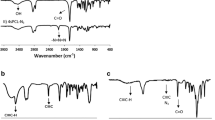Abstract
The transient dynamic swelling and dissolution behavior during the release of a growth hormone releasing peptide, [D-Trp2-D-Phe5]GHRP, from credible, non-cross-linked poly(methyl methacry-late-co-methacrylic acid) (PMMA/MAA) beads has been investigated at pH 7.4 as a function of buffer concentration. Although the swelling front penetration shows a ionization-limited behavior similar to that of nonerodible cross-linked PMMA/MAA beads, the normalized diameter of the polymer beads exhibits a brief initial rise followed by an extended linear decline due to establishment of the polymer dissolution process. This is consistent with the general kinetic scheme of dissolution of glassy polymers originally predicted for the slab geometry. In all cases, the initial gel thickness increases as a result of the ionization and swelling of the glassy PMMA/MAA beads. This is followed by an extended period of constant gel thickness due to the onset of polymer dissolution and the synchronization of movement of the swelling and dissolution fronts. The resulting constant gel layer thickness as well as the onset and duration of front synchronization shows an increasing trend with decreasing buffer concentrations. As a result, the corresponding peptide release is slower and the release duration longer at lower buffer concentrations. This is believed to be the first time that a synchronization of swelling and dissolution fronts has been documented for a spherical credible sample. Although such synchronization of fronts does not result in a constant rate of peptide release due to the spherical geometry, some non-Fickian release characteristics have been observed.
Similar content being viewed by others
REFERENCES
J. Heller. Controlled drug release from poly(ortho esters)—A surface eroding polymer. J. Control. Rel. 2:167–177 (1985).
L. M. Sanders, G. I. McRae, K. M. Vitale, and B. A. Kell. Controlled delivery of an LHRH analogue from biodegradable injectable microspheres. J. Control. Rel. 2:187–195 (1985).
P. I. Lee. Initial concentration distribution as a mechanism for regulating drug release from diffusion controlled and surface erosion controlled matrix systems. J. Control. Rel. 4:1–7 (1986).
P. I. Lee. Diffusion-controlled matrix systems. In A. Kydonieus (ed.), Treatise on Controlled Drug Delivery, Marcel Dekker, New York, 1992, pp. 155–197.
P. I. Lee and N. A. Peppas. Prediction of polymer dissolution in swellable controlled-release systems. J. Control. Rel. 6:207–215 (1987).
P. I. Lee. Diffusional release of a solute from a polymeric matrix—Approximate analytical solutions. J. Membr. Sci. 7:255–275 (1980).
P. Colombo, A. Gazzaniga, C. Caramella, U. Conte, and A. LaManna. In vitro programmable zero-order release drug delivery system. Acta Pharm. Technol. 33:15–20 (1987).
R. S. Harland, A. Gazzaniga, M. E. Sangalli, P. Colombo, and N. A. Peppas. Drug/polymer matrix swelling and dissolution. Pharm. Res. 5:488–494 (1988).
C.-J. Kim and P. I. Lee. Hydrophobic anionic gel beads for swelling-controlled drug delivery. Pharm. Res. 9:195–199 (1992).
F. A. Momany, C. Y. Bowers, G. A. Reynolds, D. Chang, A. Hong, and K. Newlander. Design, synthesis and biological activity of peptides which release growth hormone in vitro. Endocrinology 108:31–39 (1981).
A. C. Ouano. Solution properties of polymers by low angle laser light scattering photometry. J. Colloid Interface Sci. 63:275–281 (1978).
C. S. Randall, T. R. Malefyt, and L. A. Sternson. Approaches to the analysis of peptides. In V. H. L. Lee (ed.), Peptide and Protein Drug Delivery, Marcel Dekker, New York, 1991, pp. 203–246.
J. M. Samanen. Physical biochemistry of peptide drugs: Structure, properties, and stabilities of peptides compared with proteins. In V. H. L. Lee (ed.), Peptide and Protein Drug Delivery, Marcel Dekker, New York, 1991, pp. 137–166.
C.-J. Kim and P. I. Lee. Effect of loading on swelling-controlled drug release from hydrophobic polyelectrolyte gel beads. Pharm. Res. 9:1268–1274 (1992).
P. I. Lee and C.-J. Kim. Effect of geometry on solvent front penetration in glassy polymers. J. Membr. Sci. 65:77–92 (1992).
Author information
Authors and Affiliations
Rights and permissions
About this article
Cite this article
Lee, P.I. Swelling and Dissolution Kinetics During Peptide Release from Erodible Anionic Gel Beads. Pharm Res 10, 980–985 (1993). https://doi.org/10.1023/A:1018902404036
Issue Date:
DOI: https://doi.org/10.1023/A:1018902404036




